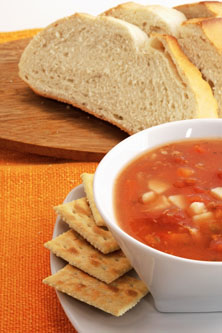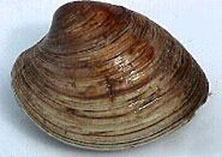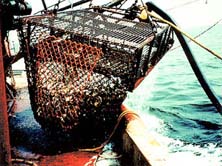Ocean Quahog (Arctica islandica)
- Ocean quahog population levels remain relatively high and fishing mortality rates are relatively low. The stock is not overfished and overfishing is not occurring.
- The ocean quahog fishery was among the first U.S. fisheries managed using an individual transferable quota (ITQ) system. The ITQ system has reduced fishing effort substantially and helped maintain productive ocean quahog and surfclam stocks in Federal waters.
- Quahogs provide a low-fat, high-quality protein and are an excellent source of selenium, iron, and vitamin B12. For more on nutrition, see Nutrition Facts. (USDA)
- Large ocean quahogs from U.S. federal waters have relatively small, dark, and tough meats and are used in processed clam products such as soups, chowder, and sauces. Smaller ocean quahogs from Maine waters are marketed as "mahogany clams" and are sold on the half-shell market or for steaming.
|
 |
 |
 |
 |
| Nutrition Facts |
| Servings 1 |
| Serving Weight
100g |
 |
| Amount Per Serving |
 |
| Calories 74 |
 |
| Total Fat |
0.97 g |
 |
| Total Saturated Fatty Acids |
0.094 g |
 |
| Carbohydrate |
2.57 g |
| Sugars |
0 g |
| Total Dietary
Fiber |
0 g |
 |
| Cholesterol |
34 mg |
 |
| Selenium |
24.3 mcg |
 |
| Sodium |
56 mg |
 |
| Protein |
12.77 g |
 |
|
 |
 Clam dredge scaffolding installed on the NOAA research vessel, Delaware II, for a surf clam and ocean quahog survey. These surveys monitor the shellfish resources and are critical for their effective management. NOAA survey cruises welcome volunteers on a space-available basis. These 2 to 3 week cruises are a great way for those interested in learning more about NOAA's survey program to get hands-on experience aboard a research vessel. Clam dredge scaffolding installed on the NOAA research vessel, Delaware II, for a surf clam and ocean quahog survey. These surveys monitor the shellfish resources and are critical for their effective management. NOAA survey cruises welcome volunteers on a space-available basis. These 2 to 3 week cruises are a great way for those interested in learning more about NOAA's survey program to get hands-on experience aboard a research vessel.
|
 |
Did you know?
The current ocean quahog resource, which is still at a relatively high biomass level, consists of quahogs that accumulated over many decades with recruitment events occurring sporadically and over small regions.
A substantial ocean quahog resource exists on Georges Bank in federal waters, but this area has been closed to harvesting of ocean quahogs since 1990 due to the risk of paralytic shellfish poison (PSP), a condition in humans caused by the ingestion of bivalve mollusks that have accumulated dangerous levels of neurotoxins from plankton.
|
|
| |
 |
|
The rings on the ocean quahog's shell can be used to tell its age. However, ocean quahogs are not aged routinely due to the difficulty involved.
|
 |
|
The majority of ocean quahogs are harvested with hydraulic clam dredges, which use jets of water to dislodge ocean quahogs from sediments.
|
|
Sustainability Status
Biomass: Biomass is 53% above the biomass needed to support maximum sustainable yield.
Overfishing: No
Overfished: No
Fishing and habitat: The principal gear used in the fishery is the hydraulic clam dredge, which uses jets of water to dislodge ocean quahogs from sediments. A smaller "dry" dredge (without hydraulic jets) is used in Maine waters. The prime habitat of ocean quahogs consists of sandy substrates with no vegetation or benthic structures that could be damaged by the passing of a hydraulic dredge. The overall area impacted by the clam fisheries is relatively small (approximately 100 square nautical miles), compared to the large area of high energy sand on the continental shelf. Any impacts to Essential Fish Habitat are considered temporary and minimal.
Bycatch: There is no significant bycatch of any other species. Hydraulic dredges are not known to have any impacts on marine mammals, turtles, seabirds, or other species protected by law.
Aquaculture: There is currently no aquaculture of ocean quahogs in the U.S.
|
Science and Management
In federal waters, ocean quahog is managed by the Mid-Atlantic Fishery Management Council through the Atlantic Surfclam and Ocean Quahog Fishery Management Plan.
With the exception of a relatively small component off the coast of Maine, the federal quahog fishery is managed by under a single individual transferable quota (ITQ) system that was established for ocean quahog and Atlantic surfclam (Spisula sodidissma) in 1990. ITQ is a system that gives private property rights to fishermen by assigning a fixed share of the catch to each fisherman. In 2002, various measures were implemented to improve management, including multi-year quotas and provisions for use of automatic vessel monitoring systems (VMS) aboard fishing vessels.
The ocean quahog fishery off Maine is managed under a relatively small quota that is separate from the quota used to manage the ITQ fishery. Ocean quahogs off Maine are managed separately because of differences in biological, fishery, and market characteristics.
|
Life History and Habitat
Life history, including information on the habitat, growth, feeding, and reproduction of a species, is important because it affects how a fishery is managed. For example, based on research about quahog growth, longevity, and recruitment patterns, scientists and managers know that ocean quahogs are slow growing and have low recruitment levels, making them relatively unproductive and able to support only low levels of fishing (removals of a few percent per year).
- Geographic range: Ocean quahog are common around Iceland, in the eastern Atlantic as far south as Spain, and in the western Atlantic as far south as Cape Hatteras, North Carolina.
- Habitat: Ocean quahogs live at depths from 25 to 1,300 feet. Further north, they are found in shallower water closer to shore. The U.S. stock is almost entirely within federal waters (3-200 miles from shore), except for a modest amount off the coast of Maine, and at depths between 65 and 260 feet. Eggs and larvae are planktonic and drift with the currents until they become juveniles and settle to the bottom. Ocean quahogs are rarely found where bottom water temperatures exceed 60º F. They burrow in a variety of substrates, especially fine sand.
- Life span: Ocean quahogs are among the longest lived marine organisms in the world. Off Southern New England, in the Mid-Atlantic Bight, and on Georges Bank, ocean quahogs can live to at least 200 years.
- Food: Ocean quahogs are filter feeders. They use their siphons which are extended above the surface of the substrate to pump in water and food particles. Quahogs feed mostly on algae.
- Growth rate: Ocean quahogs grow slowly after age 20, which is also when many individuals reach the sizes currently harvested by industry.
- Maximum size: Most quahogs in U.S. waters are 2.8 to 4.3 inches in shell length.
- Reaches reproductive maturity: Ocean quahogs begin to mature at about age 6.
- Reproduction: Quahogs spawn over a protracted interval from summer through autumn. Larvae are free-floating and may drift far from their spawning location because they develop slowly and do not settle to the bottom for more than 30 days. Major recruitment events appear to be separated by decades.
- Spawning season: Summer through fall.
- Spawning grounds: At depths of 26 to 1,300 feet on sandy bottoms. Further north, they are found (and spawn) closer to shore.
- Migrations: None.
- Predators: Many animals prey on ocean quahogs, including invertebrates such as rock crabs, sea stars, and other crustaceans, and fish such as longhorn sculpin, ocean pout, haddock, and cod. Predation rates are low because ocean quahogs burrow and have robust and thick shells that close completely, providing substantial protection.
- Commercial or recreational interest: Commercial
- Distinguishing characteristics: Ocean quahog is a bivalve mollusk, meaning it has two hinged shells that enclose its body. Its shells are thick and broadly oval. The outside is a dull gray with growth rings that can be used to tell its age. The interior is white with a purple border.
|
Role in the Ecosystem
Ocean quahogs are among the most widely distributed and abundant bivalves in marine ecosystems. Because they are such efficient filter feeders, they can absorb paralytic shellfish poisoning toxins from plankton under some conditions.
|
Additional Information
Market name: Clam, Hard
Vernacular names: Quahog, Black Clam, Hard Clam
|
Biomass
 Biomass refers to the amount of ocean quahog "meats" in the ocean. Scientists cannot collect and weigh every single quahog to determine biomass, so they use models to estimate it instead. These biomass estimates can help determine if a stock is being fished too heavily or if it may be able to tolerate more fishing pressure. Managers can then make appropriate changes in the regulations of the fishery. Biomass refers to the amount of ocean quahog "meats" in the ocean. Scientists cannot collect and weigh every single quahog to determine biomass, so they use models to estimate it instead. These biomass estimates can help determine if a stock is being fished too heavily or if it may be able to tolerate more fishing pressure. Managers can then make appropriate changes in the regulations of the fishery.
Total ocean quahog biomass has been gradually decreasing since the late 1970s. Surveys from the NOAA's Northeast Fisheries Science Center indicate that ocean quahog biomass has declined by about 75% off Delmarva and 50% off New Jersey, where the traditional southern fishing grounds are located, since 1982. In contrast, the surveys indicate relatively high and stable biomass off Long Island, in Southern New England, and on Georges Bank. Overall, ocean quahog biomass remains relatively high and fishing mortality rates are relatively low. The stock is not overfished and overfishing is not occurring.
Landings
 Landings refer to the amount of catch that is brought to land. Ocean quahogs were first harvested commercially during World War II off Rhode Island. Total landings never exceeded 2,000 metric tons of shucked meats until 1976. Annual ocean quahog landings decreased from about 23,000 metric tons from 1979 to 1983 to about 20,000 metric tons of meats during 1987-1993. Landings declined from 1994 to 2000, increased from 2001 to 2003, but declined in 2005 to about 13,000 metric tons meats, which was the lowest level since 1980. Landings from Maine waters are minor. Market demand is the primary factor affecting ocean quahog landings. Landings refer to the amount of catch that is brought to land. Ocean quahogs were first harvested commercially during World War II off Rhode Island. Total landings never exceeded 2,000 metric tons of shucked meats until 1976. Annual ocean quahog landings decreased from about 23,000 metric tons from 1979 to 1983 to about 20,000 metric tons of meats during 1987-1993. Landings declined from 1994 to 2000, increased from 2001 to 2003, but declined in 2005 to about 13,000 metric tons meats, which was the lowest level since 1980. Landings from Maine waters are minor. Market demand is the primary factor affecting ocean quahog landings.
Biomass and Landings
 Are landings and biomass related? Landings are dependent on biomass, management measures in the fishery, and fishing effort. Are landings and biomass related? Landings are dependent on biomass, management measures in the fishery, and fishing effort.
Data sources:
Biomass and landings from NMFS Northeast Fisheries Science Center Status of Fishery Resources off the Northeastern U.S. - Ocean Quahog
|
Important Dates
1977 – Surfclam-Ocean Quahog Fishery Management Plan (FMP) is implemented; establishes annual quotas for ocean quahogs and effort limitation, permit, and logbook provisions,
1990 – ITQ management is established by the Mid-Atlantic Fishery Management Council under Amendment 8 to the Surf Clam-Ocean Quahog FMP
1991 – Management of the ocean quahog resource off Maine is addressed in Amendment 10 to the FMP
2002 – Amendment 13 implements various measures to facilitate efficient management, including multi-year quotas and provisions for use of automatic vessel monitoring systems (VMS) aboard fishing vessels
|
Notes and Links
General Information:
NMFS Northeast Fisheries Science Center Status of Fishery Resources off the Northeastern U.S. - Ocean Quahog
Ocean Quahog, Arctica islandica, Life History and Habitat Characteristic
Fishery Management:
History of the Surfclam Ocean Quahog Fishery Management Plan
Stock Assessments:
2007 Assessment of Ocean Quahog
|
| |
|



